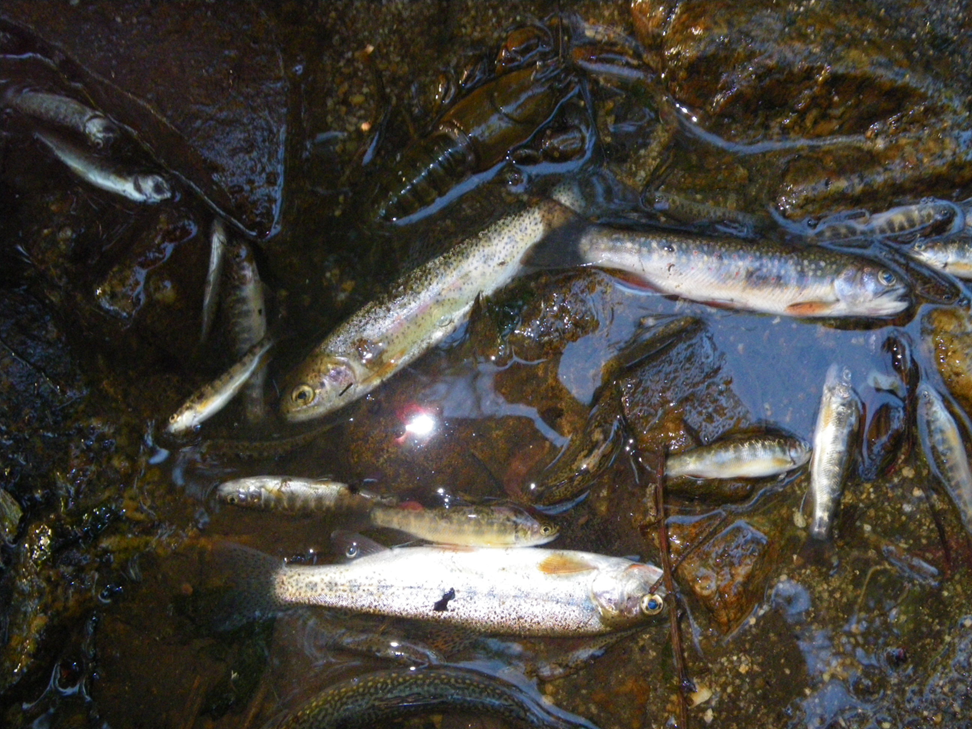Dead trout on Rye Creek on July 17, 2024. The weather across Montana has been in the high 90s and low 100s for more than a week, and forecasters predict at least another week of unseasonably hot temperatures (Photo via George Ochenski).
You really can’t make this stuff up. The Big Hole River is completely shut down to fishing due to low flows and high temperatures; the Blackfoot River is at record lows; streams all across the state are under “hoot owl” restrictions due to low water, and fish are dying.
It’s no great secret that Gov. Greg Gianforte has no love for the Department of Fish, Wildlife and Parks. In fact, he actually sued the agency over a fishing access site on the East Gallatin River near one of his homes. Safe to say he’s no friend to anglers, fish or the rivers that support what used to be some of the greatest wild trout fishing in the world.
When he stepped into the governor’s office, he appointed Hank Worsech, the former Executive Director of the Board of Outfitters as the agency’s director, much to the dismay of experienced staff, public lands hunters and anglers, and conservationists who correctly feared he would favor large landowners and outfitters instead of the healthy fish and wildlife the agency is supposed to steward.
Now the agency’s once-proud reputation for conserving those resources has evaporated in a series of disastrous decisions including special favors to out-of-state landowners, controversial elk management changes, and spending a million dollars on farmed pheasants. Likewise, the agency’s brutal wolf eradication efforts have drawn scorn worldwide — and justified fears that the same slaughter will occur should grizzly bears be taken off the Endangered Species List.
When Worsech stepped down, Gianforte appointed Dustin Temple as director. Temple was FWP’s chief of administration — and his lack of experience in fisheries and wildlife issues could not be more evident than telling Montanans to thank irrigators for the trickle of hot water still dribbling down our waterways.
But here are the facts. Of the total 9,810 million gallons of water per day consumed in Montana, irrigators suck down a whopping 96.3% and most of that goes to grow hay for cows. To put that in perspective, the total public water supply systems use 1.6% while domestic use takes two-tenths of one percent.
Obviously, the guy who ensured there was paper in the agency copying machines thinks Montanans should thank those who take the whole loaf for the few crumbs they leave for rivers and fish. But for most people, it’s atrocious that Montana’s trout die because our rivers are dewatered to feed cows.
While Temple points to paying irrigators for water the fact is the agency has had the legal authority to lease water for instream flows since 1989. It’s had money specifically to do so since the Future Fisheries Improvement Act in 1995, which by the way, the agency opposed.
Given the $2 billion state budget surplus last legislative session, neither Gianforte nor Temple tossed a few million into a fund for water leasing. And now we are paying the price — since the list of chronically dewatered and impaired rivers in Montana only continues grow.
Maybe director Temple thinks he can fool the new in-migrants into believing his department is actually keeping water in the rivers. But if that’s the case, he needs to get out more and actually look at those dry banks and dewatered tributaries as we head into spawning season for brook, brown and endangered bull trout. Then again, getting the truth out of Temple’s agency these days is about as rare as our cold, clean and full-flowing rivers — that only exist in his imagination.

